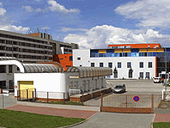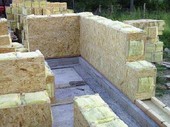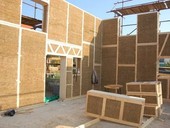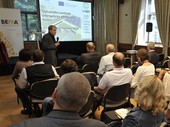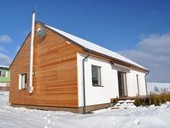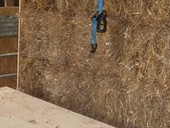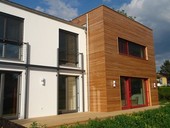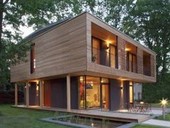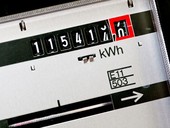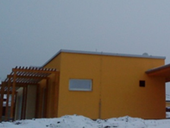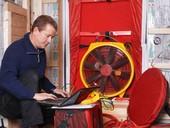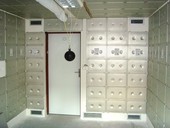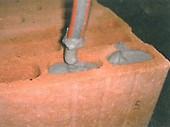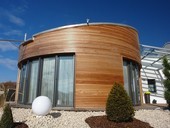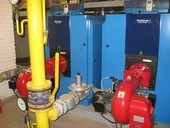Energy audit in the Czech Republic has twenty years history. The first decade was a period of searching, others ten years were period of legal obligations. The author is one of our first energy auditors. Features personal experience on the development of the methodology, legislation and practical application.
Archiv článků od 26.3.2012 do 24.9.2012
Modern construction system for low energy building, passive and zero standard or energy-autonomous buildings and increased popularity of solid wood construction means interventions into the very structure, its statics, building physics, as well as fire protection properties. Some prototype design solutions are not proven, whether tested, by trustworthy computing analysis nor verification of long-term use of the building.
Determination of the energy balance of required building is necessary in energy evaluation, energy audit and energy performance certification of buildings. Key values are heat gains and losses. They are initial for determination of the energy demand and consumption. Calculation of the energy performance should be done in accordance to ČSN EN ISO 13790 standard. This article describes the problematic calculation of glazing solar gains. In the end is enumeration of different methods (current and older) during the heating season.
The use of straw bales as insulation and in some low-rise buildings as elements for substructure are currently namely on the edge of building technologies but it is also technology that have potential in certain contexts to a wider application. It is shown by the implementation of experimental structures and research results.
This paper investigates the use of activity-explicit Marginal Abatement Cost Curves (MACC) to design abatement strategies. It shows that introducing inertia, in the form of the cost in time of available options, changes significantly the message from MACCs. With an abatement objective in cumulative emissions (e.g. emitting less than 200 GtCO2 in the 2000-2050 period), it makes sense to implement some of the most expensive options before exhausting the potential of the cheapest ones. With abatement targets expressed in terms of emissions at one point in time (e.g. reducing emissions by 20% in 2020), it can even be preferable to start implementing the most expensive options if their potential is high and their inertia is significant. Also, the best strategy to reach a short-term target depends on whether this target is the ultimate objective or there is a longer-term target. The best way to achieve Europe's goal of 20% reduction in emissions by 2020 is different if this objective is the ultimate objective or if it is only a milestone in a trajectory toward a 75% reduction in 2050. The cheapest options may be sufficient to reach the 2020 target but may create a carbon-intensive lock-in and making the 2050 target unreachable. These results show that without perfect foresight and perfect credibility of the long-term carbon-price signal, a unique carbon price in all sectors is not the most efficient approach. Overlapping sectoral objectives, such as the 20% renewable energy target in Europe, fuel-economy standards in the auto industry, or changes in urban planning, building norms and infrastructure design may be part of an efficient mitigation policy.
The paper was presented on EAERE 2012 conference.
Full version of the paper is available here: Vogt_WPS5803.pdf
Environmental economists conference EAERE 2012 continued by the second day of lectures. Plenary Keynote Lecture named Integrated Assessment Modeling in Economics and Climate Change was held by prof. William D. Nordhaus from Yale University, USA. The lecture was followed by Plenary Panel Session on Rio +20 conference.
The article deals with the assessment of economic benefits to the passive house reference object. It quantifies the cost of building and operation of the house, determines the energy performance and return on investment, depending on the method of financing. It also draws attention to the incalculable advantages, such as the constant supply of fresh air.
The assessment is a comparison of hot water production using photovoltaic devices in combination with a small heat pump and conventional solar thermal collectors. Research shows that with the same areas of the collectors, investment cost are similar, but a variant of solar electricity with small heat pump can save significantly more energy.
Construction of straw often attracts a supporter of natural building, however we encounter a critical rejection of orthodox among builders. Post of architect Aleš Brotánek analyzes using straw in facades of wooden buildings, which seems to be questionable at present. It defends its environmental advantages, but also a convenient fire resistance of over 120 minutes due to protection (external and internal) non-flammable layers of clay and a thickness of 50 mm and lime plaster thickness of 30 mm. The application of straw is accompanied by practical examples, including installation.
This article is based on the diploma thesis which investigates the behaviour of passive buildings by using parameter studies in the Czech weather conditions (9 locations were selected for the studies).
Three model objects (intentionally simplified) were designed for the parameter studies. They represent the common types of residential buildings – isolated one-family house, row family house and multiple dwelling house. The influence of various parameters is analysed on these objects.
The PHPP (PassivhausProjektierungsPaket) method was applied for the calculations. In the study following values are watched: the energy use for heating, heat loss and solar gain and the overtemperature in summer.
For example such parameters as the window size, window quality, building orientation, inner temperature were varied in the parameter studies. So called “standard objects” with U-values according to the Czech standard ČSN 73 0540-2:2007 were also included in some parameter studies.
When assessing the sustainability it is needed to take into account in addition to environmental objectives as well as financial resources. All decisions during construction depend on the resources. Low budget targets and passive house standard can be easily merged together. It is important that designers optimally apply all known ways to reduce costs during construction.
At a European level a Directive of the European Parliament and Council 2010/31/EU on the energy performance of buildings (EPBD) has been released in 2010 whereas the main requirement is to reduce energy consumption in buildings (replacing 2002/91/EC). A set of European standards have been issued for its implementation, eg EN 15232 Energy performance of buildings - Impact of automation, control and management of buildings. In the Czech Republic the Directive was implemented by Act No. 406/2000 Coll. energy management and decree 148/2007 on the energy performance of buildings. The current global trend is characterized by promoting energy efficient technologies. The aim of this work is to summarize domestic household consumption, it´s prediction and analysis of potential energy savings by using the wiring system (BACS).
Concept of energy efficiency buildings provides provable reduction in consumption of energy in compliance with the required user’s comfort. Taking into the account the trend to minimize heat escape and heat loss and increase of the airtight buildings, the installation of controlled ventilation is one of the steps leading to the optimal sanitary requirements and the overall energy efficiency of buildings. Quality indoor environment of energy efficient buildings, as well as the maximum level of comfort in this case is a controlled ventilation system with heat recovery and hot air heating. This article presents partial monitoring in situ measurements of selected parameters of the indoor environment during the operation of the upper and lower distribution system of hot air heating and ventilation in the selected experimental building.
This paper deals with the development of measurement of the building envelope airtight in the Czech Republic. Specifies the initial criteria and mistakes that were made. Addresses in detail the current state of measuring air tightness and provides some interesting insights from practice. The paper was presented at a conference Passive Houses 2011.
Thermal stability of rooms without air-conditioning depends mainly on the thermal energy storage capacity of envelope and possible heat gains. Sensible heat storage structures, e.g. brickwork, concrete walls and slabs, usually do not have sufficient thermal storage capacity and some additional thermal storage mass is needed for cold storage. Passive cooling with thermal storage in phase change materials (PCMs) is a very effective way to improve thermal stability of the rooms with light-weight envelope. The main advantage of the phase change materials storage in buildings is the possibility to store a huge amount of heat in a rather narrow temperature interval. Passive cooling based on the latent heat storage technology can contribute to the energy and operative cost savings during summer season. The efficiency of this kind of passive cooling significantly depends on the heat transfer rates between the ambient environment and the thermal storage material. Modern administrative buildings or wooden buildings are often made of light-weight materials with rather small thermal mass. The latent heat cold storage in the phase change materials seems to be quite promising in this respect since it offers high thermal storage capacity.
Clay bricks are one of the most common material used mainly in the contruction of residential buildings. We can say that masonry is a kind of standard of building design, as all other materials are being compared with brick masonry. Few years ago, there were only full bricks. In connection with the development requierements of heat transfer coefficient of the wall, the structure of the bricks is changing. Currently avaliable bricks are suitable for one-layer masonry of passive houses. The article presents an overview of the development of bricks and outlook for the future.
The design concept of passive houses is not a contradiction. On the contrary, higher quality of architecture is likely to increase the sustainability of a passive house. Architect Werner Friedl presents the passive house in words and pictures some of his built passive houses in a practical design, including construction details.
zpět na aktuální články
